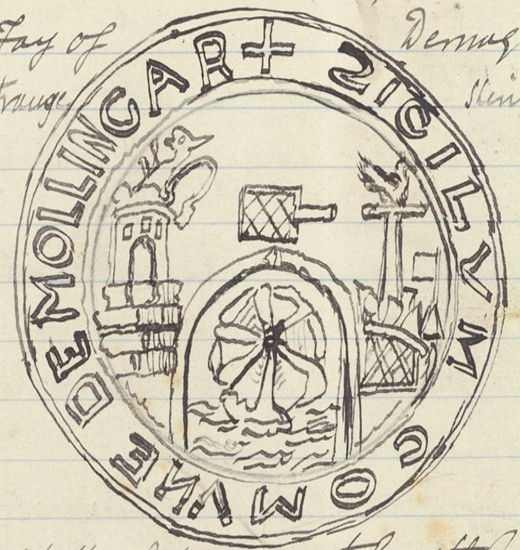Parochial History of Mullingar (13th-19th Centuries)
By collaborating with the parish of Mullingar in County Westmeath, the RCB Library has been able to digitise a volume in the parish record collection entitled a ‘Scrapbook of William Reynell relating to the history of the Parish of Mullingar, 13th – 19th cent.’ The source was brought to the Library’s attention by a parishioner and keen local historian, Harry Haskins. With the support from the parish, the Library was enabled to have the volume expertly digitised by Informa, and from 1st October 2019, it will be presented online as a digital resource where it should be of great value to local historians and others, together with a supporting introductory text by Harry, illustrated by key archives within the volume.
Several branches of the Reynell family lived in the Mullingar area for at least three generations before the Revd William Reynell was born in 1836. His great-grandfather Richard married Dorcas, daughter of Robert Cooke of Cookesborough, Co. Westmeath, another well-known family in the Mullingar area. Further background about the parish’s history is provided in the online presentation. The author of the Mullingar scrapbook was not only an ordained minister of Church of Ireland, he was also a renowned antiquary and scholar who carried out extensive research on the succession of clergy of the Church with related historical investigations. Much of Mr Reynell’s ministry was served in several different parishes in the dioceses of Derry and Kilmore, but he retained a close affiliation for the parish of his birth.

According to Mr Reynell, All Saints’ Church, Mullingar, was first referred to in a charter of 1192-1202, which noted that the church had been given to the Augustinian priory of Llanthony Prima in Wales by Simon of Rochford, Bishop of Meath. The link with Llanthony was retained until the Dissolution of the Monasteries in 1540 during the reign of Henry VIII.
The name Molyngar has received various interpretations. Amongst them, the mill on the left side of the stream, the dumb mill, the red mill and the short mill, but today the accepted translation is the left-handed mill. Mr Reynell’s volume includes his sketch of the town’s seal, now in the National Museum of Ireland, which bears the chief device of a ‘mill wheel’.
Additionally the volume contains many other antiquarian notes, sketches, cuttings and transcribed documents, documenting the evolutionary history of the parish and the town, all of which may be viewed in a page-turning viewer on the online exhibition and accompanied by the introductory text.
Commenting on the project, on behalf of Mullingar Union of Parishes, the rector, Canon Alastair Graham, recorded his thanks to Dr Susan Hood and the staff in the RCB Library ‘for their wonderful valued support with the digitization of the Mullingar History Book, and its imaging,’ adding that ‘the parish greatly looks forward to reading the history online and I am sure the history will be of considerable interest to many people.’
Canon Graham continued: ‘The parish is furthermore greatly indebted to our parishioner Harry Haskins who, as the presentation reveals, came across this key part of the unique history of Mullingar, and thoughtfully decided to approach the Library, who responded so warmly to his request and offered him invaluable support.
‘Harry has been a true blessing to the parish. This undertaking is particularly special and it has only come about through his interest and commitment. Renewed thanks and deep appreciation.’
The digitized version of Mr Reynell’s scrapbook will be available at www.ireland.anglican.org/library/archive
Further information about Mullingar Union of Parishes is available at www.mullingarunionofparishes.net